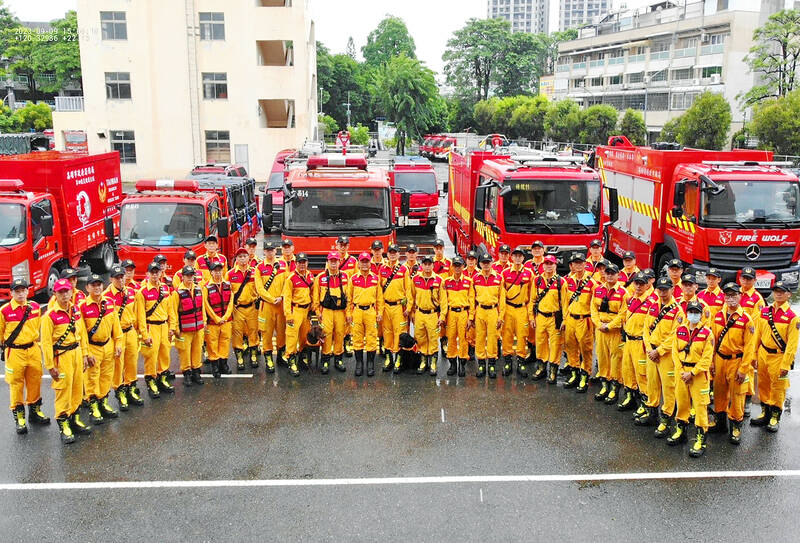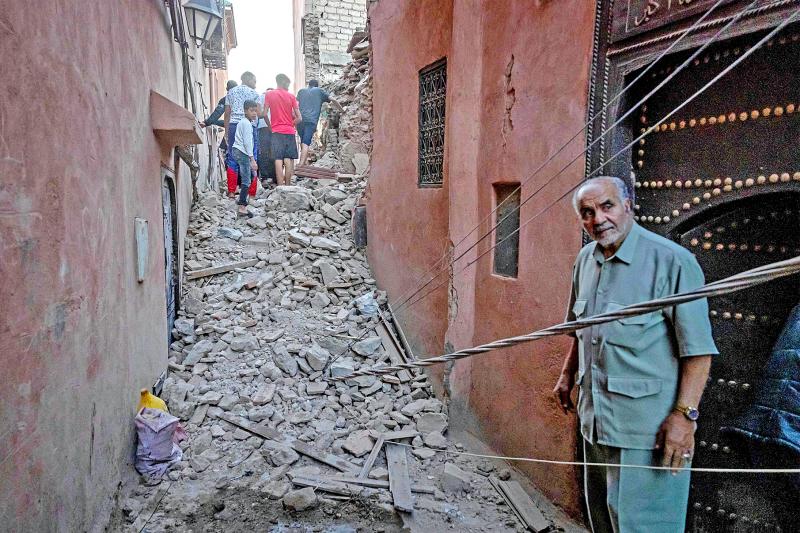A rare, powerful earthquake late on Friday struck Morocco, killing more than 1,000 people and damaging buildings from villages in the Atlas Mountains to the historic city of Marrakesh.
At least 1,037 people died, mostly in Marrakesh and five provinces near the quake’s epicenter, and 1,204 people were injured, the Moroccan Ministry of the Interior reported yesterday morning.
Of the injured, 721 were seriously hurt, it said.

Photo courtesy of the National Fire Agency via CNA
The full toll was not known as rescuers struggled to get through boulder-strewn roads to the remote mountain villages hit hardest.
Rescuers worked through the night, searching for survivors in darkness, dust and rubble.
State television showed people clustered in the streets of Marrakesh, gathered outside buildings that might still be unstable. Many wrapped themselves in blankets as they tried to sleep outside.

Photo: AFP
The magnitude 6.8 earthquake was the hardest to hit Morocco in 120 years, and it toppled buildings and walls in ancient cities made from stone and masonry not designed to withstand quakes.
“The problem is that where destructive earthquakes are rare, buildings are simply not constructed robustly enough to cope with strong ground shaking, so many collapse, resulting in high casualties,” said Bill McGuire, professor emeritus of geophysical and climate hazards at University College London. “I would expect the final death toll to climb into the thousands once more is known. As with any big quake, aftershocks are likely, which will lead to further casualties and hinder search and rescue.”
In a sign of the huge scale of the disaster, Moroccan King Mohammed VI ordered the armed forces to mobilize air and land assets, specialized search and rescue teams and a surgical field hospital, a statement from the military said.
Despite an outpouring of offers of help from around the world, the Moroccan government had not formally asked for assistance, a step required before outside rescue crews could deploy.
In Taipei, the Ministry of Foreign Affairs said that no Taiwanese were harmed or otherwise affected by the quake to its knowledge.
Taiwanese traveling or living in Morocco are urged to stay vigilant and those who need assistance can call the Provence annex of the Taipei Representative Office in France at +33-413911920.
For emergencies, Taiwanese in Morroco should call +33-7611415 20 or the Ministry of Foreign Affairs emergency contact center in Taiwan at 0800-085-096, it added.
In Marrakesh, the famous Koutoubia Mosque, built in the 12th century, was damaged, but the extent was not immediately clear. Its 69m minaret is known as the “roof of Marrakesh.”
People also posted videos showing damage to parts of the famous red walls that surround the old city, a UNESCO World Heritage site.
Most of the tiny village of Moulay Brahim, carved into a mountainside south of Marrakesh, was uninhabitable after walls crumbled, windows shattered and more than a dozen homes were reduced to piles of concrete and bent metal poles. At least five residents were trapped.
Ayoub Toudite said that he had been working out with friends at the gym when “we felt a huge shake like it was doomsday.”
In 10 seconds, he said, everything was gone.
“We found casualties and people running and kids crying,” he said. “We never saw anything like this, 20 deaths in the area, 30 injuries.”
Additional reporting by staff writer

The CIA has a message for Chinese government officials worried about their place in Chinese President Xi Jinping’s (習近平) government: Come work with us. The agency released two Mandarin-language videos on social media on Thursday inviting disgruntled officials to contact the CIA. The recruitment videos posted on YouTube and X racked up more than 5 million views combined in their first day. The outreach comes as CIA Director John Ratcliffe has vowed to boost the agency’s use of intelligence from human sources and its focus on China, which has recently targeted US officials with its own espionage operations. The videos are “aimed at

STEADFAST FRIEND: The bills encourage increased Taiwan-US engagement and address China’s distortion of UN Resolution 2758 to isolate Taiwan internationally The Presidential Office yesterday thanked the US House of Representatives for unanimously passing two Taiwan-related bills highlighting its solid support for Taiwan’s democracy and global participation, and for deepening bilateral relations. One of the bills, the Taiwan Assurance Implementation Act, requires the US Department of State to periodically review its guidelines for engagement with Taiwan, and report to the US Congress on the guidelines and plans to lift self-imposed limitations on US-Taiwan engagement. The other bill is the Taiwan International Solidarity Act, which clarifies that UN Resolution 2758 does not address the issue of the representation of Taiwan or its people in

US Indo-Pacific Commander Admiral Samuel Paparo on Friday expressed concern over the rate at which China is diversifying its military exercises, the Financial Times (FT) reported on Saturday. “The rates of change on the depth and breadth of their exercises is the one non-linear effect that I’ve seen in the last year that wakes me up at night or keeps me up at night,” Paparo was quoted by FT as saying while attending the annual Sedona Forum at the McCain Institute in Arizona. Paparo also expressed concern over the speed with which China was expanding its military. While the US

SHIFT: Taiwan’s better-than-expected first-quarter GDP and signs of weakness in the US have driven global capital back to emerging markets, the central bank head said The central bank yesterday blamed market speculation for the steep rise in the local currency, and urged exporters and financial institutions to stay calm and stop panic sell-offs to avoid hurting their own profitability. The nation’s top monetary policymaker said that it would step in, if necessary, to maintain order and stability in the foreign exchange market. The remarks came as the NT dollar yesterday closed up NT$0.919 to NT$30.145 against the US dollar in Taipei trading, after rising as high as NT$29.59 in intraday trading. The local currency has surged 5.85 percent against the greenback over the past two sessions, central